 Texture
Texture
Texture is an Astute Graphics live effect for Adobe Illustrator that makes it simple to add one or more raster-based textures to art objects. Each texture’s blending mode, scale, rotation, and position can be specified. Textures can be imported and exported for sharing with other users. The live effect is controlled by both a panel and a tool. Texture is part of the Texturino plugin.
Texture Tool
Tool Location and Cursor Appearance
The Texture tool appears in Illustrator’s main toolbar (which must be in Advanced mode: View > Toolbars > Advanced). Stacked under it is the associated Texture Brush tool.

Texture Tool Location
The Texture tool’s cursor assumes several shapes, depending on what the cursor is hovering over:

Texture Tool Cursors
Additionally, the cursor will change to a finger when it is over an annotated menu or button.
Texture Tool Operation
As the Texture tool has several keypresses which can add or change its functionality, we suggest installing the free Astute Graphics plugin Astute Buddy, which creates a panel that dynamically updates to inform you of the various keys which can be pressed in the tool’s current context.
The Texture tool allows a Texture live effect’s parameters to be changed using an on-screen, annotated widget. All selected art objects with Texture live effects will display this widget (centered above the art’s bounding box) when the Texture tool is active, but only one of them will be “targeted” and displayed in color (red, by default) rather than gray. This texture is indicated on the Texture panel as the “current” texture.
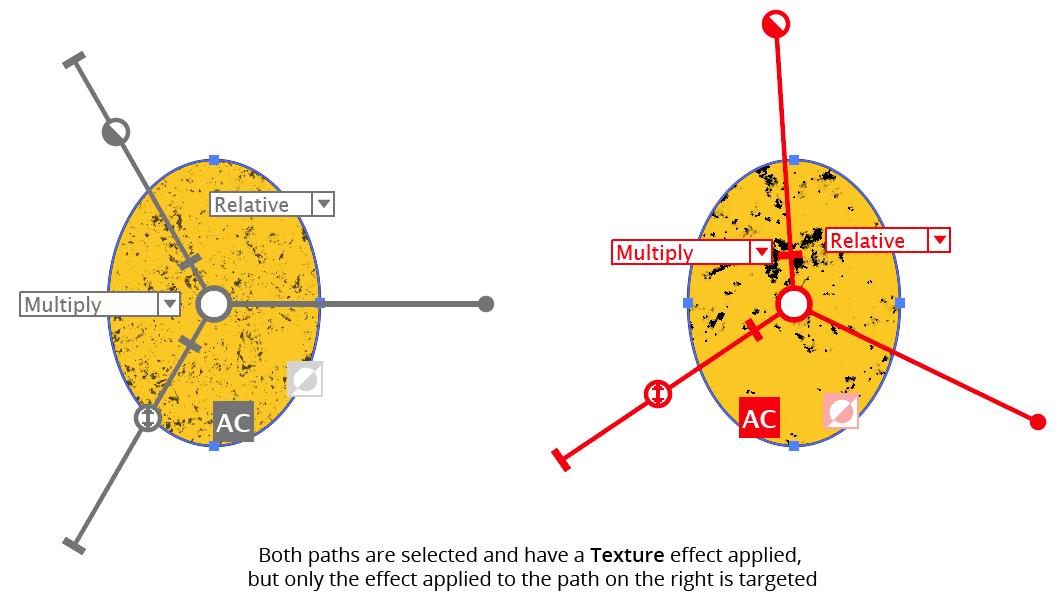
Texture Targeting Annotations
Texture Annotation Widget
The annotated widget consists of multiple controls. For all controls, the texture will update after the mouse button is released.
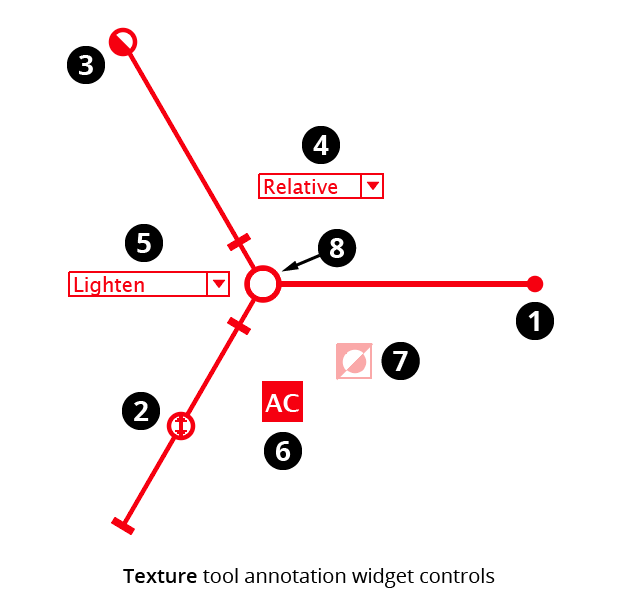
Texture Annotations
1. Rotation arm and control
Dragging the rotation control changes the angle of the texture. The texture’s current angle of rotation is displayed next to the cursor when hovering over or close to the rotation control:

Texture Rotation Display
Doubleclicking the rotation control will bring up a dialog in which the texture’s angle of rotation can be specified numerically:
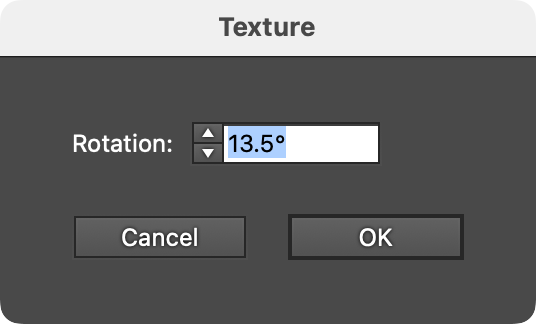
Texture Rotation Dialog
2. Scale Slider
Dragging the thumb changes the scale of the texture (keeping its center stationary), from 10000% at the outside end of the slider to 1% at the inside end. The texture’s current scaling and effective resolution is displayed next to the cursor when hovering over or close to the scale slider:

Texture Scale Display
Doubleclicking the scale slider thumb control will bring up a dialog in which the texture’s scale can be specified numerically, either as a percentage or by specifying the desired effective resolution, in pixels per inch:

Texture Scale Dialog
The default Scale setting can be set in the preferences dialog (see Texture: Preferences). Textures are always scaled the same in the horizontal and vertical directions.
3. Opacity Slider
Dragging the thumb changes the opacity of the texture, from 100% at the outside end of the slider to 0% at the inside end. The texture’s current opacity is displayed next to the cursor when hovering over or close to the opacity slider:

Texture Opacity Display
Doubleclicking the opacity slider thumb control will bring up a dialog in which the texture’s opacity can be specified numerically:
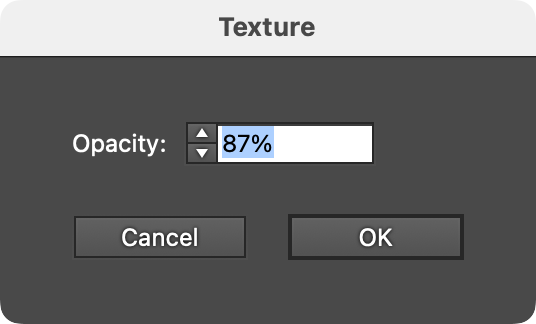
Texture Opacity Dialog
4. Position Mode Menu
Chooses the mode of positioning the texture. In Relative mode (the default), the texture’s center is positioned relative to the center of the bounding box of the art; if the art is moved, the texture will move along with it. In Absolute mode, the texture’s center is positioned at specific coordinates on the artboard; the texture will not move when the art is moved or its bounding box is changed (unless Auto-Cover is enabled; see below).
5. Blending Mode Menu
Controls the blending mode of the texture. It consists of the same sixteen blending modes that are available in the native Transparency panel, plus a special mode: Knockout. In Knockout mode, the darkness of the texture controls the opacity of the art to which it is applied; solid black areas make the art completely transparent (“knocking it out”) and therefore allowing art below it to show through.

Texture Blending Mode Examples
In the Texture Manager, each texture may be assigned an Initial Blending Mode, which is the mode given to the texture as a default (see Texture: Texture Manager).
6. Autocover Button
Toggles the Autocover parameter of the texture. When enabled, indicated by an undimmed “AC” icon, nonrepeating textures will be automatically moved and/or enlarged such that they always completely cover the bounding box of the artwork (plus any specified padding). The default Autocover setting can be set in the preferences dialog (see Texture: Preferences).
7. Invert Button
Toggles the Invert state of the texture. When enabled, indicated by an undimmed icon, the color of the texture is inverted.
8. Center control
Clicking the center control of an untargeted texture targets it.
When dragging a control on the annotated widget, the following keypresses apply:
Shift: Constrains the control’s value to a “nice” value. For Rotation, this is angles that are multiples of 45° away from the general constrain angle. For Opacity, this is steps of 10%. For Scale, this is integer percentages.
Command/Ctrl: Enables “Slow-Drag,” which moves the control as if all cursor movements were reduced by a value specified in the tool preferences (with a default of 10), allowing for finer control.
Space: Temporarily hides the tool annotations.
C: Changes the annotation color.
In addition to the annotated widget, the bounds of the targeted texture are displayed as a gray rectangle:
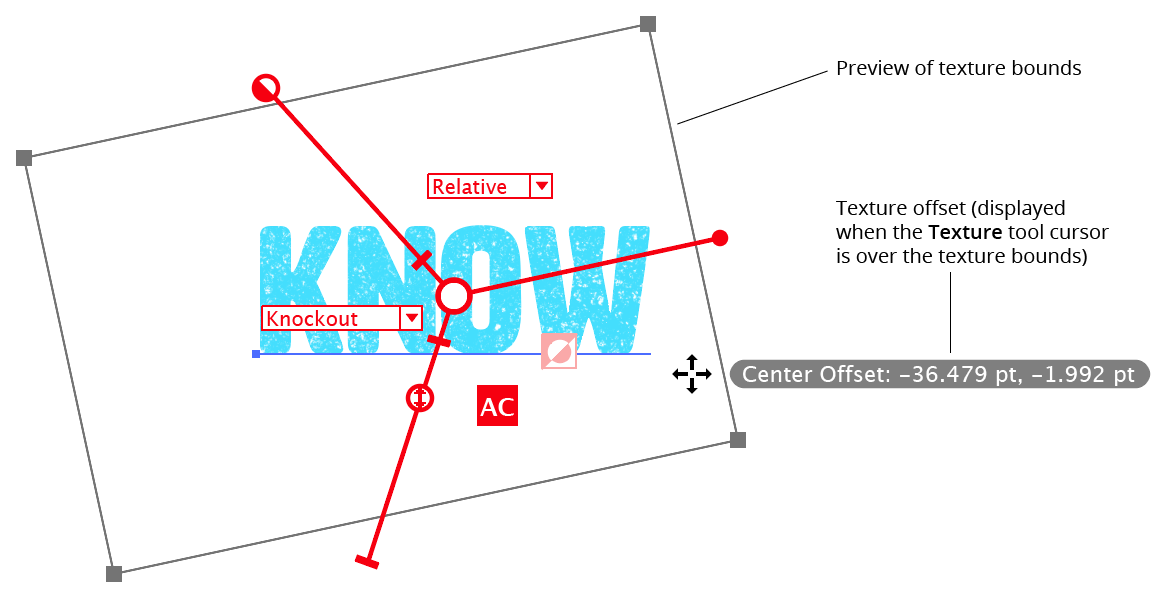
Texture Bounds Annotation
This bounds annotation may be manipulated with the Texture tool in several ways:
a. The inside of the rectangle may be dragged to reposition the texture (hold
Shiftto constrain the movement);doubleclickinginside it allows the position to be specified numerically.b. The edges and corners of the rectangle may be dragged to resize the texture; by default, this is done keeping the opposite edge/corner stationary, but holding
Option/Altwill resize it from the center.c. Hovering the cursor just outside one of the corners of the rectangle allows rotation of the texture, either by dragging (similarly to rotating an art object using its bounding box, with
Shiftconstraining the angle of rotation) or bydoubleclickingto set the rotation numerically.
If the texture is repeating, the rectangle annotation’s borders are drawn with a dashed line.
While the rectangle bounds of the texture updates in real time when rotated or resized, the actual texture will not be updated until the mouse button is released.
When nothing is selected, the Texture tool can be used to select artwork, by either marquee-dragging over it or by clicking on it.
Texture Panel
The menu item to show and hide the Texture panel can be found in the main menu under Window > Astute Graphics > Texture.

Texture Panel Overview
1. Flyout menu
See Texture Panel: Flyout Menu.
2. Panel banner
The help button on the right opens the help documentation in the Astute Manager. If this does not automatically appear, please ensure your Astute Manager is running first.
Click on the other area of the color bar to activate the Texture tool. This is a quick method of locating the tool within the default Advanced toolbar or a custom toolbar.
3. Add Button
Adds the texture being previewed on the panel to the selected artwork and (if necessary) switches the current tool to the Texture tool to allow immediate editing of the texture’s parameters, such as position, scaling, and so on, using the on-screen tool annotations (see Texture: Tool Operation).
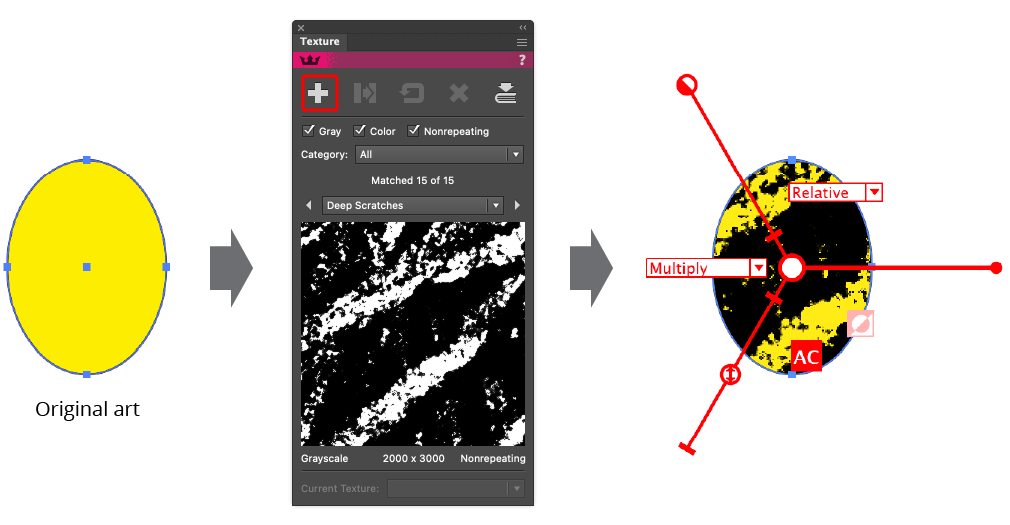
Texture Panel Add Button
Normally, when a new texture is added, its parameters are reset to their defaults, but if the Option/Alt key is held down when clicking the Add button, the parameters will be retained from the last texture that was selected or edited. Multiple copies of the same texture may be added.
4. Replace Button
Replaces the current texture (as indicated by the Current Texture menu at the bottom of the panel) with the texture being previewed on the panel, retaining all parameters.
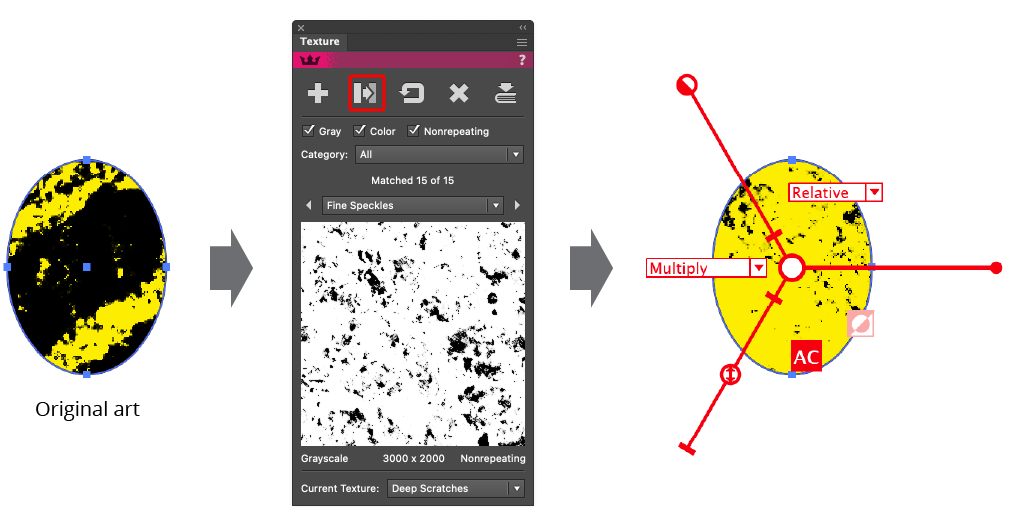
Texture Panel Replace Button
5. Reset Button
Resets the current texture’s parameters to their defaults: relative positioning with no offset; scaling 100%; rotation 0°; opacity 100%; Invert disabled; Auto Cover enabled; and blending mode equal to the texture’s “Initial Blend Mode” (set for each texture in the Texture Manager, with a default of Multiply).
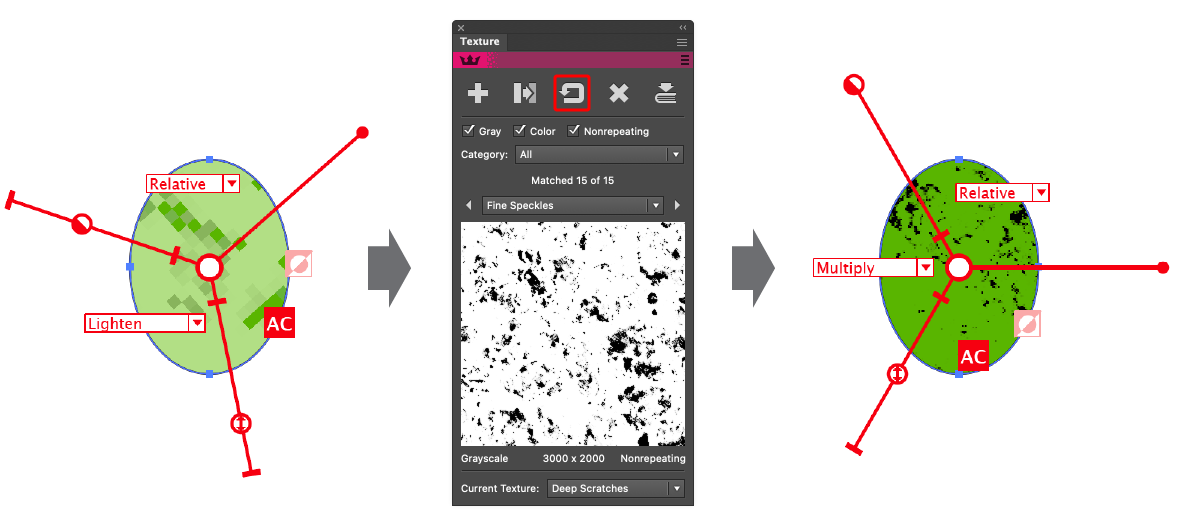
Texture Panel Reset Button
If the Option/Alt key is held down when clicking the Reset button, then all the textures in the targeted art object will be reset.
6. Remove Button
Removes the current texture (as indicated by the Current Texture menu at the bottom of the panel) from the targeted art object. If the Option/Alt key is held down when clicking the Reset button, then all the textures in the targeted art object will be removed.
7. Import Button
Allows one or more new textures to be created and added to the library from one or more existing PNG, TIFF, or JPG files, using the standard file open dialog. A warning will be shown if a texture being imported conflicts with an existing texture. After the import process has completed, a dialog will report the total number of textures that were successfully added to the library.
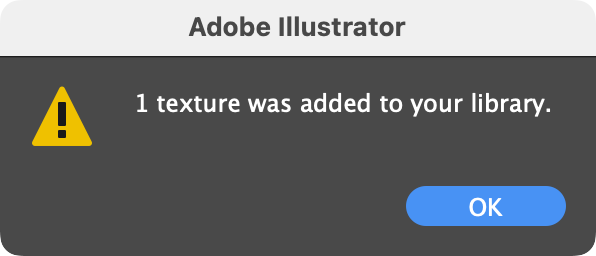
Texture Import Results Dialog
The Texture Manager will then automatically open with the newly-imported textures selected (see Texture: Texture Manager).
If the Option/Alt key is held down when clicking the Import button, the Texture Manager will be opened instead.
8. Filtering Parameters
These three checkboxes allow you to filter the textures in your library in order to make it easier to locate a desired texture. For example, if you are only interested in seeing color textures, deselecting the Gray checkbox will hide all grayscale textures from the Texture Selection menu. (Note that this only keeps matching textures from appearing in the panel’s selection menu; non-matching textures already added to artwork can still be replaced, reset, deleted, or edited using the Texture tool.) Nonrepeating textures are those which do not seamlessly repeat from left to right and top to bottom like a pattern.
9. Category Popup Menu
Choosing a category from the menu limits the textures shown in the Texture Selection menu to those textures that have that category assigned. A texture’s category can be changed using the Texture Manager (see Texture: Texture Manager). There are three special categories at the top of the menu: All, which shows textures of any category; Favorites, which shows only textures which have been favorited; and Recently Used, which shows up to five of the most recently-used textures.
10. Matching Status Line
Displays the number of textures which are currently being displayed in the Texture Selection menu (after being filtered by Gray/Color/Nonrepeating and Category), as well as the total number of textures in the library.
11. Texture Selection Area
Allows you to select a texture from the library so it may be added as a new texture to artwork or replace an existing texture. The previous and next buttons step through each texture one by one (wrapping around at the beginning and end); the popup menu allows to to select a texture directly by name, from among those textures which match the filtering checkboxes and Category menu.
12. Texture Preview Area
Displays a preview of the texture that is selected in the popup menu above it. By default, the texture is shown at actual size; if the texture is larger than the preview window, it will be cropped. To see parts of the texture outside the crop, simply place the cursor over the preview window (the cursor will change to a hand) and drag. When the cursor is over the preview window, two icons will appear near the bottom:
Texture Panel Preview Window Icons
A. Favorite Icon: Allows you to quickly change a texture’s favorite status by clicking on it (when the star is filled, the texture is a favorite).
B. Preview Size Icon: When clicked, switches the texture’s preview between actual size and fit-to-window. Each texture’s view type is retained independently.
13. Texture Properties
Displays the following properties for the selected texture: color mode, pixel size, and repeating status.
14. Current Texture Selection
Reports the “current” texture; that is, the one in the selected art object which is targeted by the tool that would be replaced or removed using the buttons at the top of the panel. The popup menu allows you to choose the current texture when the art object contains multiple textures.
Texture Panel Flyout Menu
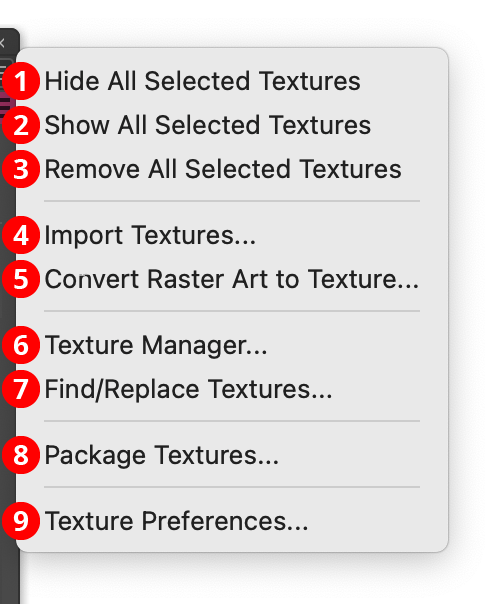
Texture Panel Flyout Menu
The Texture panel flyout menu items are contextually sensitive and all items may not be available, depending on the current selection.
1. Hide All Selected Textures
For all selected art with one or more non-hidden Texture live effects, causes their textures to be hidden, just as if their Visibility icon were clicked in the native Appearance panel.
2. Show All Selected Textures
For all selected art with one or more hidden Texture live effects, causes their textures to be shown, just as if their Visibility icon were clicked in the native Appearance panel.
3. Remove All Selected Textures
Removes all Texture live effects from all selected art objects.
4. Import Textures...
Imports new textures, as if the Import button on the panel were clicked (see Texture Panel: Import Button).
5. Convert Raster Art to Texture...
Available when one or more raster (embedded) art objects are selected, this function creates a new texture from each raster object, which remains unchanged. After conversion, the Texture Manager will automatically be opened with the newly-converted textures selected. They will have been given names like “Converted,” “Converted [1],” etc., but can be renamed.
6. Texture Manager...
Opens the Texture Manager (see Texture: Texture Manager).
7. Find/Replace Textures...
Opens the Find/Replace Textures dialog, used to locate textures, replace one texture with another, or replace textures which are missing or mismatched:
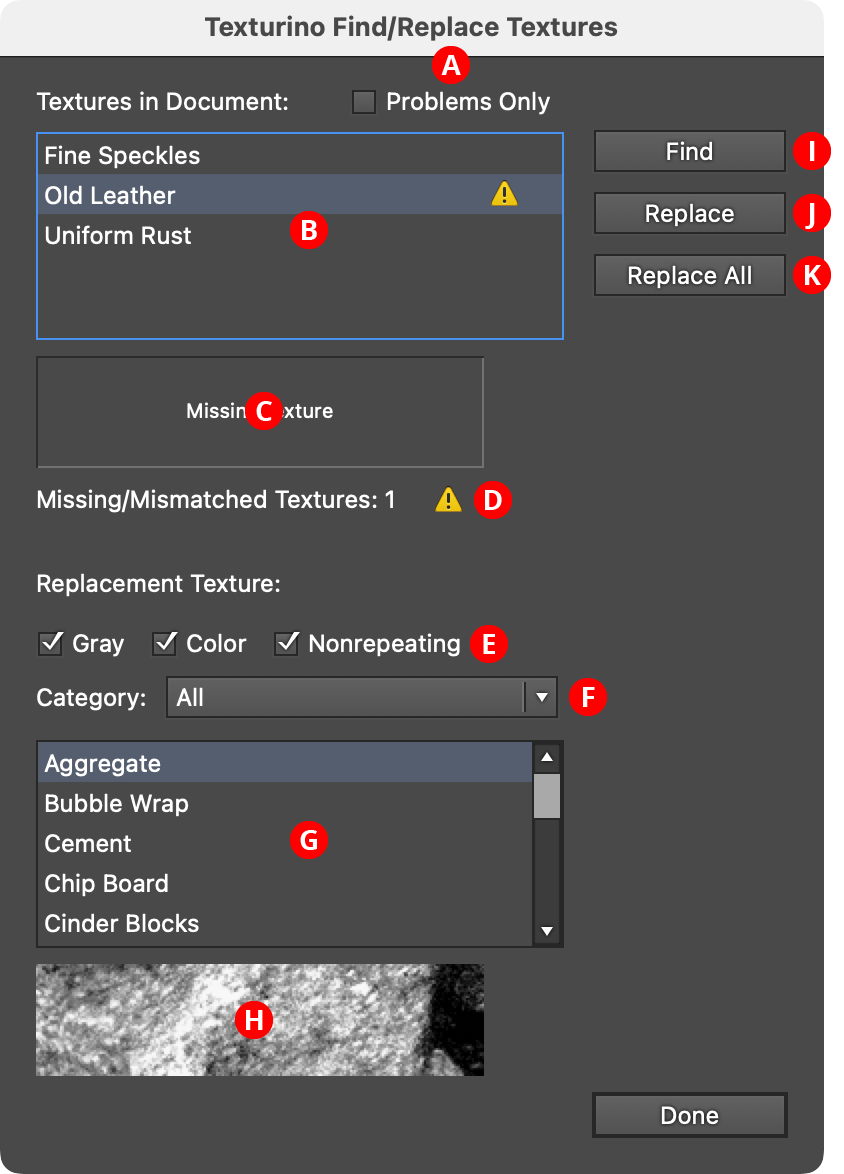
Find/Replace Textures Dialog
A. Problems Only Checkbox: When enabled, only those textures in the document which are missing (the texture cannot be located) or mismatched (a texture with the same name exists, but it is not the same texture that was originally added) are shown in the top list.
B. Textures in Document List: Lists either all the textures used in the current document, or, if Problems Only is enabled, the missing or misplaced textures in the current document. Problem textures display a warning symbol to the right of their name. When a texture is selected in the list, the document is automatically scrolled so that the first instance of the texture is centered within the document window.
C. Document Texture Preview Area: Previews the selected document texture, unless it is missing or misplaced. A clickable preview size icon will appear when hovering the cursor over the window.
D. Missing/Mismatched Status Line: Shows the number of problem textures in the current document, if any.
E. Filtering Parameters: Act the same as the filtering parameters checkboxes on the panel.
F. Category Popup Menu: Acts the same as the category popup menu on the panel.
G. Texture List: Lists textures that may be used for replacement (textures that match the filter parameters and category specified above).
H. Replacement Texture Preview Area: Previews the selected replacement texture. A clickable Preview Size icon will appear when hovering the cursor over the window.
I. Find Button: Each time the Find button is clicked, the artwork containing the next instance of the selected document texture is selected, and the document is scrolled so that artwork is centered within the document window.
J. Replace Button: Replaces the single instance of the texture that was originally selected or subsequently located using the Find button with the replacement texture, keeping all of its live effect parameters unchanged. Afterwards, the document is automatically scrolled to the next instance of the texture, if any.
K. Replace All Button: Replaces all instances of the selected texture in the document with the replacement texture, keeping all of their live effect parameters unchanged.
All texture replacements made while the Find/Replace Textures dialog is open can be undone in a single operation after the dialog is closed. If the Find/Replace Textures... menu item is unavailable, then there are no textures in the document.
8. Package Textures...
Brings up a dialog that allows you to export all of the textures used in the current document (except missing or mismatched textures) into a folder, the name and location of which can be specified. The textures are exported in PNG format. This is useful when giving the document to another user who also has the Texturino plugin installed and needs to edit the artwork that has Texture live effects. Before opening the document, that user should import all of the textures in the packaged folder so they will be present in their library.

Package Textures Dialog
8. Texture Preferences...
Brings up the Preferences dialog (see Texture: Preferences).
Texture Manager
The large Texture Manager dialog is the central place where the library of textures can be organized. It can be reached through the panel flyout menu (see Texture Panel: Flyout Menu) or by Option/Alt-clicking on the Import Textures button on the panel.

Texture Manager Dialog
1. Column Headings
By default, the textures are sorted alphabetically by name, but clicking on any of the column headings will use that heading for sorting (either upwards or downwards; the state can be toggled by clicking again on the heading). The sorting order will be retained across sessions. Columns, which are not resizeable, include:
a. Name: The name of the texture.
b. Category: The category (if any) assigned to the texture.
c. Repeating: The repeating status of the texture (a bullet symbol indicates the texture is repeating). Textures downloaded from Astute Graphics’ Texture Packs will have the repeating flag already set; textures from other sources may need to have the flag manually set (see below).
d. Initial Blend: The initial blend mode of the texture when it is newly assigned to artwork or is reset. By default, the initial blend mode is Multiply.
e. Mode: The color mode of the texture (color or grayscale).
f. Size: The width and height of the texture, in pixels.
g. Favorite: The favorite status of the texture (a bullet symbol indicates a favorite).
2. Texture List
If the number of textures is greater than will fit in the list, a scroll bar will appear on the righthand side. Textures may be selected by clicking on them; multiple textures may be selected by Command/Ctrl-clicking on them, or Shift-clicking to select contiguous textures. The “Noise” texture does not appear in the list because is a built-in, automatically-generated texture that cannot be changed or deleted.
3. Texture Preview Area
Previews the textures that are selected in the list, similarly to the preview area on the panel except that multiple textures will be previewed when selected (up to a maximum of 24, although the preview size will get smaller for values above 2), and using the Preview Size Icon will affect all of the previewed textures collectively.
4. Rename Button
When a single texture is selected, allows renaming it through a simple dialog.
5. Category Popup Menu
Used to create categories, manage categories, or reassign the category of one or more selected textures.

Texture Manager Category Menu
A. New...
Brings up the New Texture Category dialog, allowing a new category to be created. If a new category is not assigned to any textures when the Texture Manager is exited, it will not be retained.
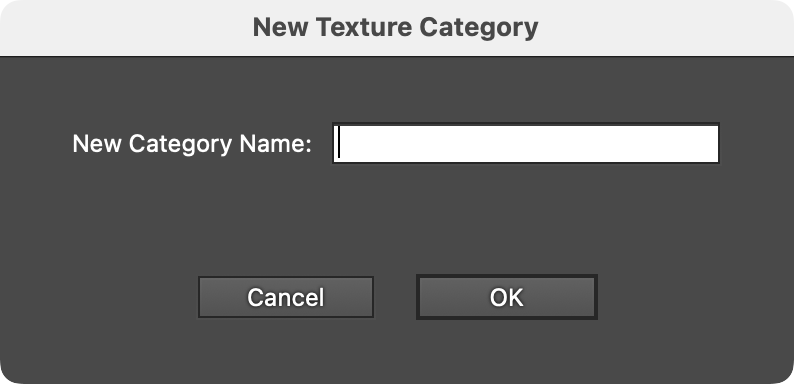
Texture Manager New Category Dialog
B. Manage...
Brings up the Manage Category dialog, in which categories selected in the list may be renamed or deleted. Since the “Noise” category is built-in and cannot be renamed or deleted, it is not shown in the list.
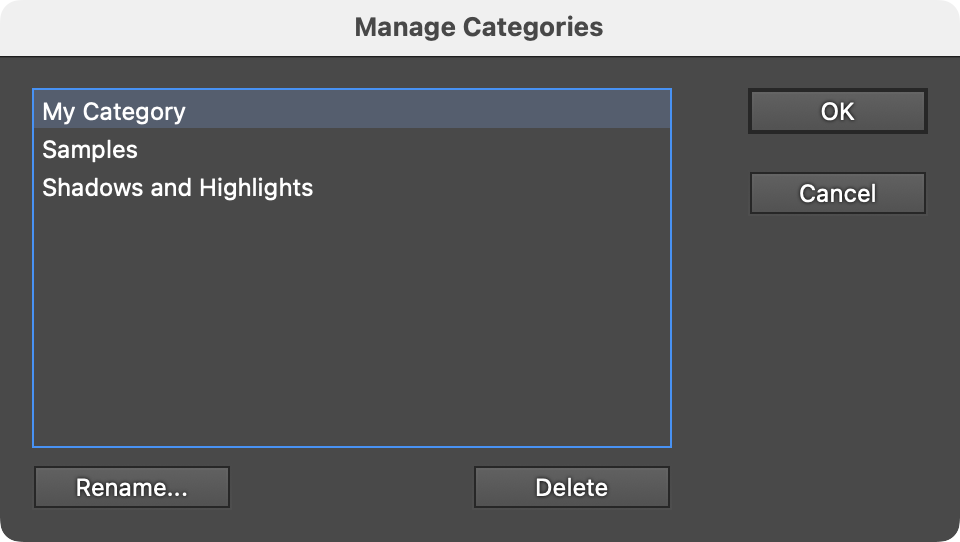
Texture Manager Manage Categories Dialog
C. [None]
Removes any category from the selected textures.
D. Category List
Assigns the chosen category to the selected texture(s). The contents of this section of the menu will vary, depending on which categories exist.
6. Repeating Checkbox
Turns the repeating flag on or off for the selected texture(s). When the flag is on, textures that do not completely cover the artwork bounds will be tiled so that they do.
7. Initial Blend Popup Menu
Assigns an Initial Blending mode to the selected texture(s).
8. Favorite Checkbox
Turns the favorite status on or off for the selected texture(s).
9. Export Button
Allows the selected texture(s) to be exported (in PNG format) into a folder specified using the standard OS folder picking dialog.
10. Delete Button
Deletes the selected texture(s). Deleting a texture that is currently being used in an open document will cause a warning dialog to be displayed before deletion occurs.
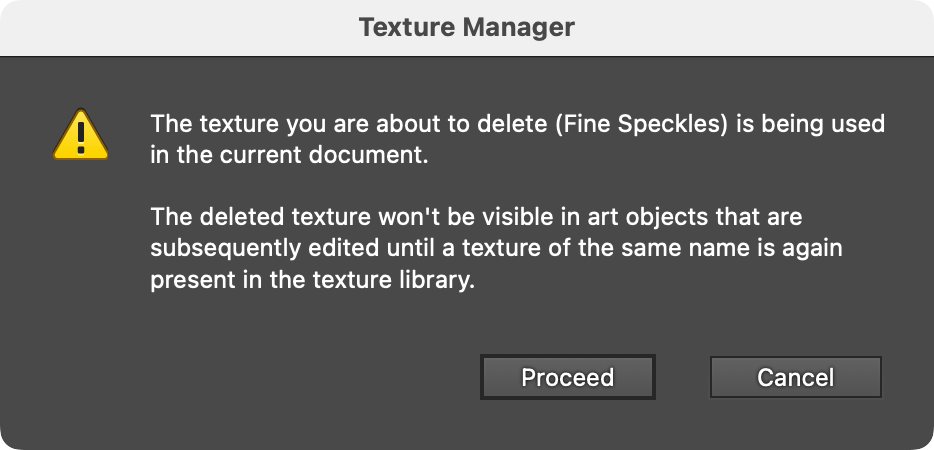
Texture Manager Deleted Texture in Use Dialog
If the Texture Manager is closed using the Cancel button, all of the changes that were made to any of the textures while it was open, including deletion, will be reverted, and all textures will remain as they were before the Texture Manager was opened.
Texturino stores some texture properties (category, repeating flag, initial blending mode) as metadata directly in each texture’s png file, in order that these values are preserved if the textures are exported and imported on another machine. So if any of these values are changed in the Texture Manager, the disk files of those changed textures must be updated. This process happens when Illustrator is quit, and may cause a sizeable delay if there are many changed textures or they are very large. It is essential not to force quit Illustrator before Texturino is done updating the metadata, or the textures will not have retained their new properties on the next launch.
Textures are internally saved to the following location:
Texture Preferences
Using the flyout menu of the Texture panel, doubleclicking the Texture tool in the toolbox, or pressing the Enter key when the tool is selected will bring up the Texture preferences dialog:

Texture Preferences
1. Annotation Color
Allows a choice of colors in which to annotate the on-screen widget, from among red, blue, magenta, green, and black.
2. Slow-Drag Divider
Specifies the factor by which the cursor’s movement will be divided when using Slow-Drag (see Texture: Tool Operation). The value can range from 1 to 500, with higher values allowing for smaller movements of the cursor.
3. Texture Background
Allows the background color of the preview windows of the Texture panel, Texture Manager, and Find/Replace Textures dialog to be specified, either as a checkered transparency grid or as a specific flat color. When set to Specific Color, the color can be changed by clicking on the color chip to bring up the standard color picker.
4. Default Texture Scaling
Specifies the scaling value that will be used when adding a new texture or resetting an existing texture; the default is 100%.
5. Default Autocover Setting
Specifies the autocover setting that will be used when adding a new texture or resetting an existing texture; the default is Enabled.
6. Crop Textures
When enabled, textures are cropped down to the smallest size necessary to cover the artwork (taking the padding value into account). This makes the Illustrator file smaller, since the entire texture does not need to be included. However, if the Texture live effect were ever to be expanded, then the resulting raster image may not include enough “extra” area to accommodate edits to the artwork.
7. Padding
The “extra” amount of image to leave on all sides of the texture before cropping it; the value can range from 1 pt to 1000 pt (but may vary slightly, as image dimensions must be in an integer number of pixels).
8. Downsample Textures After Expand
When enabled, and the appearance of an art object with a Texture live effect is expanded, the resulting raster image is downsampled to the specified value if its effective resolution is higher.
9. Downsampling Value
The desired downsampled texture resolution, ranging from 1 to 2400 pixels per inch.
10. Informational area
Shows a brief description of each preference control when the cursor is being hovered over it.
11. Help Button
Opens the help documentation in the Astute Manager. If this does not automatically appear, please ensure your Astute Manager is running first.
Texture Special Considerations
Missing and Renamed Textures
While textures have unique names, they are actually kept track of internally using their contents. As an example, suppose a texture called “Texture A” is applied to a path and its document is saved and closed. Now suppose “Texture A” is renamed as “Texture B”. When the document is then opened, Texture detects that although “Texture A” no longer exists, a texture with the exact same contents (i.e., pixel for pixel) exists under the name “Texture B,” so it automatically uses the new name.
If instead of being renamed, “Texture A” were deleted, then when the document is opened, Texture will not be able to find a matching texture under any name, and will therefore display the missing textures warning dialog:
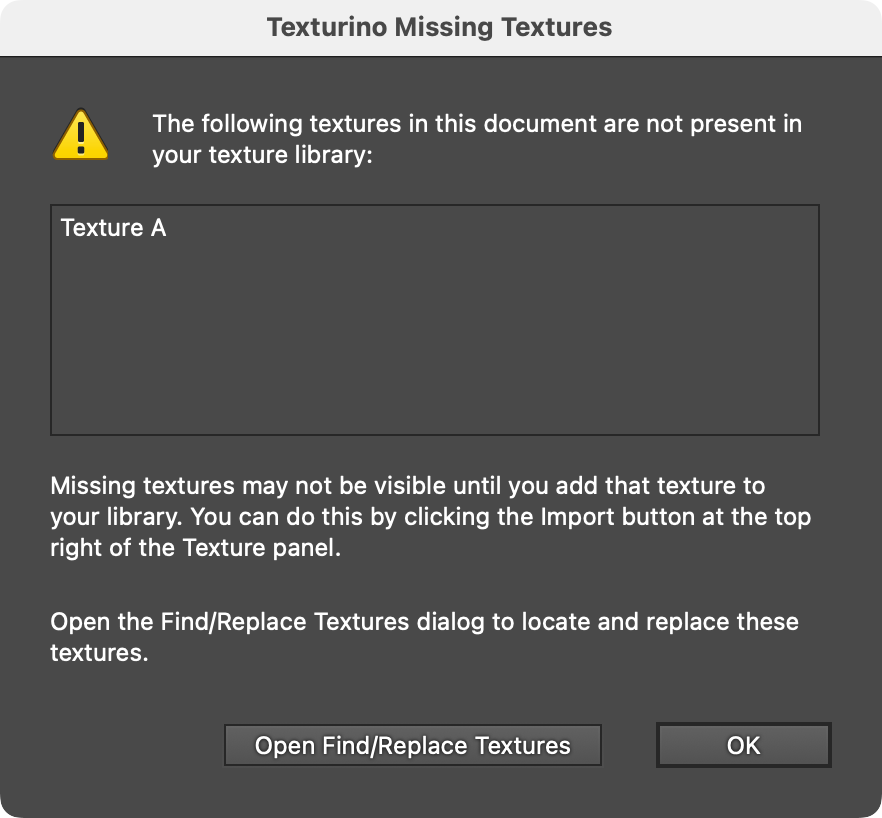
Missing Textures Warning Dialog
Finally, if after deleting “Texture A,” a different texture is named “Texture A,” then upon opening the document, Texture will detect that the current texture with the same name does not have the same contents as it did when it was added, and will display the mismatched textures warning dialog:
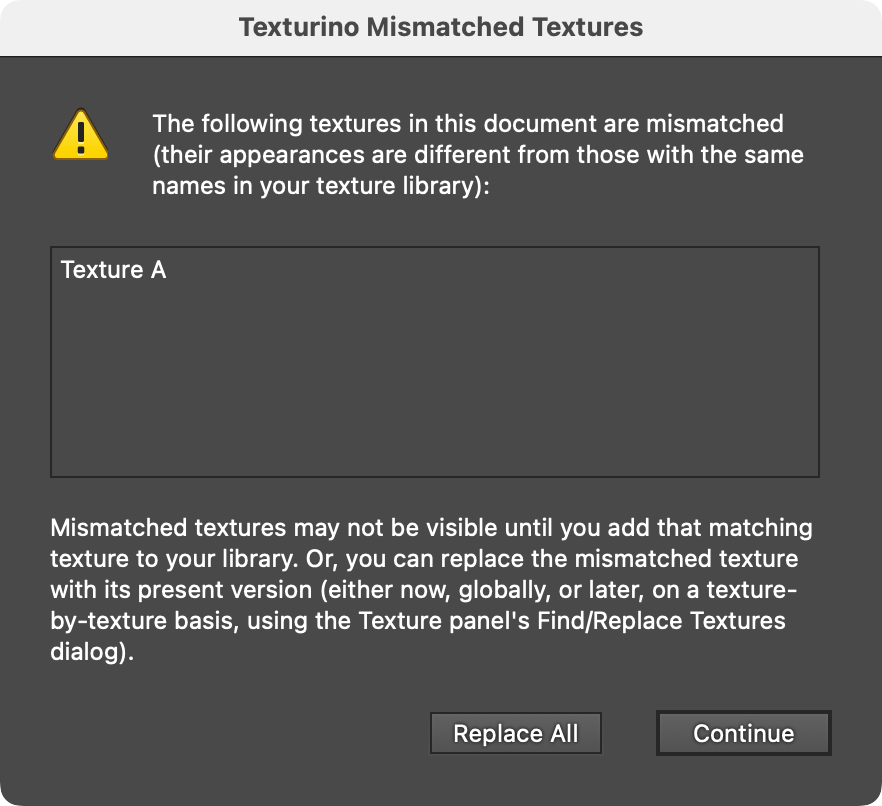
Mismatched Textures Warning Dialog
Texture: Fill and Strokes
Internally, Texture is creates a clip group consisting of an outline of the art and the raster texture. Because standard (centered, constant-width) strokes are not expanded by default when the art is outlined, a texture will not appear in an artwork’s strokes as initially added, only its fills. However, a stroke can be included by simply using the Appearance panel to place a native Outline Stroke live effect in the stroke section of the artwork. To create a texture only in the stroke, still use the Outline Stroke live effect but move the Texture live effect directly below it, inside the stroke section.
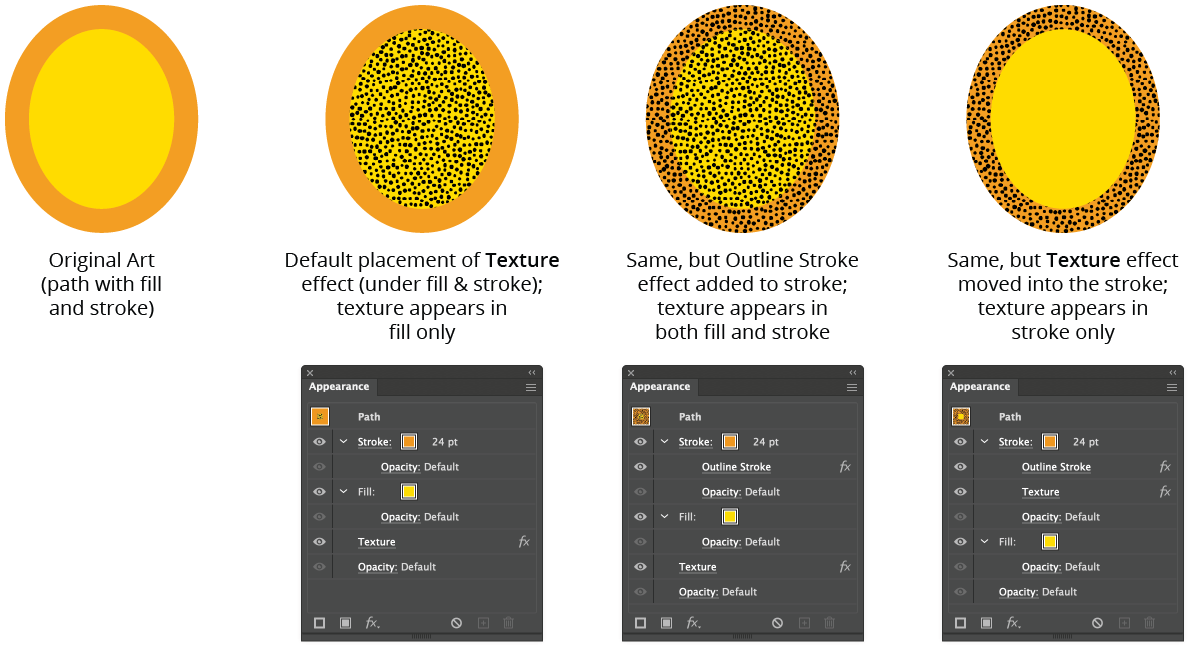
Texture on a Stroke Example
